Farmer's dance at the rice-planing.
Thursday, March 31, 2011
Dance - again!
Farmer's dance at the rice-planing.
Wednesday, March 30, 2011
Korea Labor Institue: Visting Researcher Program
The Korea Labor Institue (KLI) Visiting Researcher Program
Korea Labor Institute is accepting applications for its 2011 Visiting Researcher Program.
For those who are interested and want to apply, please send the following documents by email:
(1) a letter of recommendation,
(2) a research proposal,
(3) a curriculum vitae,
(4) an application form (can be downloaded from their website), and
(5) two sample papers
Contact Person: min@kli.re.kr
Website: http://www.kli.re.kr
Note: Click the post title to go to the original link!
Tuesday, March 29, 2011
Korean DanceTaepyeongmu (태평무)
Sejong university is one of the leading schools in Korea with a strong standing in animation, dance, music, rhythmic gymnastics and fine arts departments.
When the photographs were taken it was a venue for the prestigious Inter- School National Dance Championships 2003, in differnt dance forms and I got to see some of the best performances (for free) for almost a month.
This student in the photograph was at the time a high school student (junior) equivalent to an intermediate level in Pakistan.
She performed Taepyeongmu (태평무), which symbolizes a dance to wish great peace for the country.
There are three assumptions regarding the origin of Taepyeongmu. One is a court dance occasionally performed by the royals during the Joseon dynasty. Therefore, the costumes used by the dancers are similar to the gwanbok (hangul: 관복; literally "official clothing") formerly worn by Korean royal family.
| Same student as above, practicing before her performance: photographed by the author of this blog |
Taepyeongmu is designated as one of the Important Intangible Cultural Properties of South Korea.
Monday, March 28, 2011
Remembering Cheonan

[평택] 3월 26일, 천안함 피격 1주기를 맞아 곳곳에 분향소가 설치됐다. TV에서는 관련 프로그램이 연이어 방영되고, 고인의 명복을 비는 애도 글과 추모행사가 온·오프라인을 넘나들며 끊임없이 이어지고 있다.
이제 겨우 스물. 앞길이 창창한 나이에 가슴 아픈 사건으로 우리 곁을 떠난 46용사와 천안함 인양 작업 도중 안타깝게 세상을 떠난 고(故) 한주호 준위를 우리는 아직도 생생히 기억하고 있다.
그래서일까. 지난 18일, 문화체육관광부 공감코리아 정책기자단과 함께 천안함이 보존된 국방부 평택 제2함대로 향하는 발길은 무겁기만 했다.
지난 18일 오전 11시, 약 스무 명의 정책기자단이 서울 서초구청 앞 분수대에 모였다. 대절한 버스에 올라타 주최 측에서 정성껏 준비한 점심 도시락을 먹은 우리는 곧바로 평택으로 떠났다.
따스한 날씨에 가벼운 마음으로 출발했던 것도 잠시, 관계자의 안내를 받으며 들어선 해군 제2함대 기지 안은 이내 숙연한 분위기로 정적에 휩싸였다.

왼편으로 선명한 포탄 자국이 남은 커다란 함선이 눈에 들어왔다. 정책기자단을 위해 미리 연락을 받고 달려나온 스물 두 살의 이성주 상병은 “참수리 357호입니다. 예전 연평해전 때 바로 저 함정에서 북한군과 교전을 벌였죠. 지금은 탐방객들을 위해 전시하고 있습니다.”라며 말문을 열었다.
서해 교전 당시 우리나라 해군들은 저 함선에서 얼마나 긴박한 위기의 순간을 보냈을까. 이야기를 듣는 기자들의 표정이 한층 엄숙해졌다.
제1연평해전 전승비와 제2연평해전 전적비로 향한 기자단은 이곳에서 잠시 묵념의 시간을 가졌다. 연평해전에서 목숨을 잃은 6명의 장병을 포함해, 우리나라를 지키려다 장렬히 전사한 많은 호국 영령들을 위한 것이었다. 그들의 노고와 커다란 희생이 있었기에 모든 국민이 안심하고 발 뻗고 잠을 잘 수 있었다는 생각이 드니 가슴 한 구석이 아려왔다.

다음은 천안함 전시 현장 견학 순서였다. 쌍끌이어선으로 인양해 온 천안함이 탐방객들을 위해 당시 발견된 모습 그대로 전시돼 있었다.
연돌(함정의 굴뚝 역할을 하는 부분으로 폐기를 밖으로 내보낼 때 이용된다)이 통째로 날아가고 커다란 초계함이 두 동강이 난 처참한 모습에 정책기자단은 차마 입을 다물지 못했다. 뉴스와 신문을 통해 사진으로만 보아오던 것과는 차원이 다른 심각한 모습이었다.
천안함 사건 설명을 맡은 김경연 대위는 사건의 발생 개요부터 차근차근히 설명해나가기 시작했다. 2010년 3월 26일 밤 9시 22분, 백령도 남방 2.5km 지점에서 서해 NLL(북방한계선) 경비 임무를 수행하던 중 피격 당해 침몰한 천안함은 총 46명이라는 많은 전사자를 배출한 비극 중의 비극이다.
함정의 함수, 함미를 천천히 돌아가며 듣는 정확하고 실감 넘치는 설명은 순식간에 기자단 모두를 사로잡았다. 앞길이 창창한 젊은 나이에 아까운 목숨을 잃은 천안함 용사 46명의 생각에 저절로 눈시울이 붉어졌다.
그동안 많은 논란을 불러일으켜 온 천안함 침몰 음모론에 대한 명쾌한 설명도 뒤따랐다. 장장 6가지에 달하는 침몰 원인설을 김 대위는 하나씩 반박했다. 북한의 비접촉 어뢰 모형을 직접 보여주며 기자단이 가진 의문에 대해서도 자세히 답변해워 모두들 속이 시원한 표정이었다.

모든 안내를 마친 후 김 대위는 다음과 같이 덧붙였다. “제가 여러분께 이렇듯 자세히 설명해 드린 건 여러분이 우리나라의 정책기자단이시기 때문이에요. 국민 여러분께 보다 바르고 정확한 보도를 해주시길 바랍니다.”
기지 내 안보교육관에서 영상 관람까지 마친 후 돌아오는 길, 정책기자단이 탄 버스에는 적막이 감돌았다. 제각각 보고 들은 내용을 바탕으로 상념에 빠진 모습이었다.
기자는 국민의 눈과 귀를 담당한다. 언론의 역할이 중요한 것은 그들이 하고 쓰는 말 한 마디, 글 한 줄이 국민에게 끼치는 영향이 엄청나기 때문이다. 그런 점에서 이번 평택 해군 제2함대 안보현장 탐방은 국가 안보의 중요성뿐만 아니라 기자로서의 사명감까지 깨달을 수 있었돈 계기가 되었다.
다시는 천안함 사건과 같은 가슴 아픈 비극이 일어나지 않기를, 그리고 기자들 역시 국민들에게 올바르고 공정한 보도를 함으로써 더 나은 대한민국을 만들어갈 수 있기를 간절히 바란다.
Credits@ 이승하(대학생)
emal: cahira@korea.ac.kr
Man vs. Machine
Native Nepali men crossing a river - in late 1800s.
Sunday, March 27, 2011
Yeouido (Yeoui Island, 여의도, 汝矣島)
 Yet another overpass (fly-over)!
Yet another overpass (fly-over)!Saturday, March 26, 2011
Seoul's City Hall
 I took this picture in 2006.
I took this picture in 2006.I heard that the Seoul Metropolitan Department is planning some changes in the infrastructure of the historic Seoul City Hall.
The futuristic Spatial Layout Strategy is covered by the Dezeen and the project is called: City Hall ‘Madang’ (Courtyard).

‘City Hall Madang’ (courtyard) at the center of the complex can connect and unite all of the diverse programs along the perimeter of varying heights. Since Madang can be approached from all directions within the site and is accessible to all as a public urban lobby, it is the most public of spaces inside the complex. This Madang will not only be an iconic open space defined by the old and new City Hall, but also function as a unique urban catalyst for social activities of Seoulites. Madang will be linked powerfully to an iconic public space, Seoul Plaza to the south, and present another iconic three-dimensional space that contrasts with the Seoul Plaza’s flatness.
It will look something like this below.
Friday, March 25, 2011
Late March Snowfall!
March has a history of heavy, record breaking snowfalls in Korea.
In 2003, in the second week of March, we witnessed one of the heaviest snowfalls in 75 years of the history of Seoul. In 2010, it happened again - a record breaking snowfall was witnessed all over Korea.
Korea's four seasons are "very distinct" and breathtaking.
Anyhow, it seems that jackets, coats and layers and layers of clothing are here to stay for a month or so. ;-(
Thursday, March 24, 2011
March 23, 2011: A Day to remember!
We are really looking forward to a semi-final between India and Pakistan - that would be the best, the most anticipated match of the World Cup 2011 and a 'real' entertainment at large for the masses. The venue is no doubt very special, Bangladesh, which started playing International Cricket not long ago and have been doing very well. They did a very good job in hosting this event.
My Indian friend also asked about the importance of 23rd March, because Rameez Raja and Afridi during the prize distribution mentioned it and therefore, I explained it at length.
I have heard it several times from my Indian friends, a desire, that it would not have been bad if India and Pakistan were one country. On 23rd March 2011, I heard it again. It is an interesting idea indeed! In my opinion (minus the serious debate on the issue), if we were ONE COUNTRY then, we only had one team for all the sports including cricket to cheer for, but now, we have 3 teams: Pakistan, India and Banglaesh - which is very good. This partition actually created jobs, lessened the already fierce competition and a lot of 'masala' for both the print and the electronic media on which companies and people have become millionaires.
Some recent media-hyped coverages include: Sania and Shoaib's marriage - this marrige was greeted with a mixture of horror and delight on both sides. It would not have been a 24/7 mantra for the media last summer if we were one country. Even Koreans were talking about it who have least interest in the showbiz/sports stories of the Sub-continent.

Another equally interesting event was the teaming up of India's Rohan Bopanna and Pakistani Aisam-ul-Haq Qureshi in Tennis, who call themselves as "the Indo-Pak Express", who are actually making history and creating a lot of hype on both sides of the border and at an international level too. In an interview with CNN, the Indian Sport's Minister said,"I have one question for everyone: if Bopanna-Qureshi can play together, why cannot India and Pakistan?" ;D
We would never have heard of the term "Cricket Diplomacy."
If we were one, our list of favourite actors and singers would have been a very interesting combination. I wonder, what it would have been like for movies with Anjuman and Amitabh as co-actors or Sultan Rahi and Shabana Azmi pairing up for a Punjabi movie. For music, well the limit is the sky. If we were one, would 'Big Boss' be so controversial and such a big deal?
Now that we are seperate countries we have tensions, over religion, disputed territories and a never-ending blame game and so if we were one - who would we be blaming for all the evils in our respective countries.
Well, together we are sitting on a time-bomb, armed to the teeth and spending billions on a never-ending rat race of nuclear arms acquisition and heavy defense budgets - which, otherwise, would have gone for better causes and sectors that are neglected such as education and health care-sounds like fiction.
As one country, Taliban at one front and Shivsena on the other, WOW! A double trouble scenerio. Would there have been an alliance between the two? An alliance to harass the public in the name of religions.
Anyhow, what is done is done! I hope we can still fare well if there are more oppotunities for 'a people to people contacts and exchanges'. I am postive that one day we will have a tension free, exciting and stable sub-continent in general, and a peaceful SAARC region in particular!
We need to have one goal: to attain peace through dialogue!
If a country is one or not : matters less.
Wednesday, March 23, 2011
Jinnah: Quaid e Azam
 Mohammad Ali Jinnah (Founder of Pakistan)
Mohammad Ali Jinnah (Founder of Pakistan)While looking for anything in the category of Jinnah Archives - all I found in google search included: Wikipedia's Jinnah page, Jinnah - Gems of Pakistan, Faraz Mushtaq's jinnah dot pk and an article 'Jinnah: Secular or Islamist'.
I was really hoping to see a governmental portal to top the list but I was wrong. One success, among these hits and misses, was a book review by Barbara Crossette of Dr, Akbar S. Ahmed's book: Jinnah, Pakistan and Islamic Identity: Search for Saladin; Routledge, 1997.It goes like this:
Islam gave the Muslims of India a sense of identity; dynasties like the Mughals gave them territory; poets like Allama Iqbal gave them a sense of destiny. Jinnah's towering stature derives from the fact that, by leading the Pakistan movement and creating the state of Pakistan, he gave them all three. For the Pakistanis he is simply the Quaid-i-Azam or the Great Leader. Whatever their political affiliation, they believe there is no one quite like him.
She finally refers to one important question that crosses everybody's mind every now and then - and so it has the author's mind which is: should there have been a Pakistan at all? On this point Ahmed has no doubt, and in answering that question he raises an explosive issue rarely discussed in the subcontinent.
''What if Jinnah were to come alive to see the mess that is his Pakistan?'' he asks, and then he answers: It would still look better than Muslim life in Hindu-dominated India. With Hindu fundamentalism on the rise, there is ample evidence to back his assertion that pogroms, poverty and prejudice have dogged those Muslims who stayed behind after partition. Though still a rough work in progress, Ahmed concludes, Jinnah's Pakistan was worth the fight.
This book review was published in The New York Times and can be read in detail on links at the end of the post.
Another fantastic find was via my sister's recommendation to look for Jinnah Papers. They are undoubtedly a rich source of a first hand account about Jinnah and Pakistan. It is a lifetime spent by Dr. Zawwar Husain Zaidi on this rather difficult and labourous academic work that he undertook. We all know that this is a topic that lacks scholarship due to the difficulty in finding the original sources. This will prove to be a stepping stone for researchers and scholars in the future. It is an enormous body of work and in this regard Dr. Zaidi in one of his interviews said;
" … The Quaid-e-Azam Papers can be divided into five broad categories (i) personal, (i) political, (iii) published material, (iv) photographs and (v) maps and diagrams."
I think that we must read Jinnah Papers to know the founder of this country a little better.
LINKS for Dr. AKbar's Book:
http://www.nytimes.com/books/97/12/14/reviews/971214.14crosset.html?_r=2
OR
http://www.nytimes.com/books/first/a/ahmed-jinnah.html
A whole chapter is available here:
http://www.amazon.com/Jinnah-Pakistan-Islamic-Identity-Saladin/dp/0415149665#reader_0415149665
Probably the whhole book is available FREE online; have to search more for this.
Some additions on Jinnah related sites..
http://m-a-jinnah.blogspot.com/
Tuesday, March 22, 2011
Pakistan Day
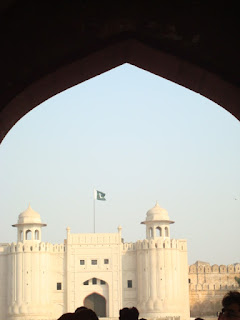
Shahi Qila (Lahore Fort)

Minar e Pakistan
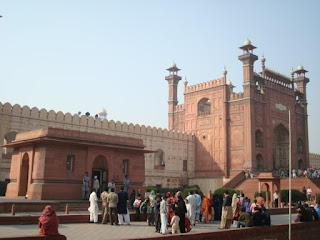 Allama Mohammad Iqbal's final resting place
Allama Mohammad Iqbal's final resting placePakistan celebrate the 23rd of March as Pakistan Day, every year, with great zeal and enthusiasm. Officially, a lot of events are arranged by Pakistan embassies around the world at a governmental scale. As a nation and at an individual level things have changed in the past few years for almost all of us.
We grew up celebrating Pakistan Day in our own way. I still remember that all of us siblings and our friends from the neighborhood used to decorate the houses and the street with colorful trimmings, decorations and jhandiyan with a Pakistani flag on them. I also remember that my mother used to advice us to make sure that the decorations with a flag on them do NOT fall on the ground – as it is disrespectful. In the spirit of Pakistan Day, almost all the houses had Pakistan’s flag flying high on the roof tops. In the evening, we used to light candles on the walls of the house and sometimes ‘oil diyas’ as they could last wind better than the candles. We used to save money for Pakistan day from our pocket moneys and used to pray for not having a rain on 22 and 23rd of March.
Today, as I write this, I miss those days, the spirit of bonding with Pakistan and the spirit of being ONE with it. This day reminds me of my brother tremendously - who was a staunch believer in Pakistan and even though he was as a kid himself, hardly 10 years old, he was my role model and my inspiration to celebrate Pakistan Day. His jazba, josh, janoon (enthusiasm)and leadership to organize various events at that tender age was worth seeing. He was the one who chose to stay in Pakistan. He is no more but on every Pakistan Day, I miss his patriotism, his endless love for Pakistan and his efforts to help people improve their life - in his capacity.
I also remember that my mother and grandmother used to sit in front of TV (we just had one channel PTV - until 1991) to listen to Quraish Pur, Laeeq Ahmed, Azhar Lodhie and Obaidullah Baig teaming up with experts - covering Pakistan Day Parade, flag hoisting ceremonies and change of guard ceremony at at the Mazar e Quaid and Mazar e Iqbal. My mother always prepaired special food for the day and fateha was offered for those who lost their lives in million due to the partition. A few times we were lucky to participate in the festivities at the Race Course Ground in Rawalpindi. It was a big occasion not just in my house but in the country in general - at all levels; villages and cities alike.
I was in Pakistan last year; there was not much enthusiasm among kids in my neighborhood as it used to be. The spirit of oneness is dying out - even on occasions like Pakistan Day, the spirit of “US and THEM” is overshadowing almost all the events.
I am positive that things will change and change for good. If we look back, Pakistan has proved itself as an underdog - a country that has a great potential. In Trinidad an old man asked me if it is a Pakistan of Jinnah? I hope we will have a Pakistan of Jinnah and Iqbal!
I wish every Pakistani a fantastic and a memorable Pakistan Day today.
Pakistan Zindabad!
Monday, March 21, 2011
Dr. Amartya Sen's Lecture
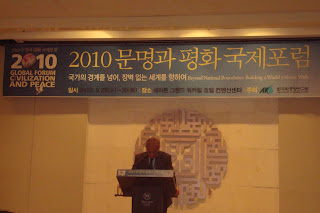
Prof. Amartya Sen
Professor of Economics, Harvard University
Nobel Laureate in Economics, 1998
Our grad school has a tradition of inviting Nobel Laureates every year. Last year's lecture was given by Dr. Amartya Sen - the Godfather of developmental economics. He asked me where I'm from in Pakistan and what is my major and showed keen interest and asked a few questions. He is very down to earth, loving and witty.
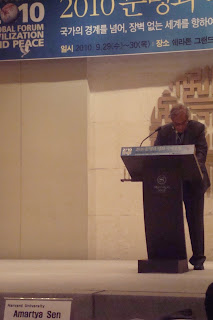
He gave a lecture on 'Global Civilization and National Boundaries'. He emphasized that the global problems demand integrated thinking and our ability - and willingness - to listen to each other. He also talked about the importance of global justice.
Dr. Mahbub ul Haq and Dr. Sen were the founders of the Human Development Theory and were also very close friends. Both have spent their lives for the betterment of the masses...
Dr. Amartya Sen while referring to the Human Development Theory said, "Human development, as an approach, is concerned with what I take to be the basic development idea: namely, advancing the richness of human life, rather than the richness of the economy in which human beings live, which is only a part of it."
Sunday, March 20, 2011
Mushroom picking

Saturday, March 19, 2011
Images of the Day
 Korean rescuers in Japan
Korean rescuers in Japan Rescue efforts by 911 Korean Rescue squad.
Rescue efforts by 911 Korean Rescue squad.Friday, March 18, 2011
Seoul Tower
Thursday, March 17, 2011
Pakistan's Soft Image
 Photographer Yoo Beyl-nam's and a guest
Photographer Yoo Beyl-nam's and a guestYoo is a Korean photographer, whose photo exhibition about Pakistan in Lahore and Seoul - were very impressive and successful. The exhibitions in Islamabad and Lahore were sponsored by Samsung - in an effort to project a softer image with an aim to explore the beauty of Pakistan and promote tourism by sponsoring such positive social events according to one official.

According to the current Korean ambassador, his book 'Insha Allah' was the only comprehensive book on Pakistan in Korea's biggest book store named Kyobo - before he moved to Pakistan and was looking for books on it.
photo credits@ Yoo Beyl's website/Korea Times.
Wednesday, March 16, 2011
Persimmons

They have low calories (provides 70 cal/100g) and fats but are a rich source of dietary fiber.
Persimmons contain many health benefits and are rich in flavonoids, poly-phenolic anti-oxidants as well as important anti-tumor compound betulinic acid. Catechins are known to have anti-infective, anti-inflammatory and anti-hemorrhagic (prevents bleeding from small blood vessels) properties.
Fresh permissions contain anti-oxidant compounds like vitamin-A, beta carotene, lycopene, lutein, zeaxanthin and cryptoxanthin. These compounds functions as protective scavengers against oxygen-derived free radicals and reactive oxygen species (ROS) that play a role in aging and various disease processes. It also helps prevent "Age related macular disease"(ARMD) in the elderly.
They are also a very good source of vitamin-C, another powerful antioxidant. Regular consumption of foods rich in vitamin C helps body develop resistance against infectious agents and pro-inflammatory free radicals. It is good in many valuable B-complex vitamins such as folic acid, pyridoxine (vitamin B-6), thiamin...etc. These vitamins acts as co-factors for numerous metabolic enzymatic functions in the body.
Fresh Persimmon fruits also contain healthy amounts of minerals like potassium, manganese (15% of DRI), copper (12% of DRI) and phosphorus. Manganese is a co-factor for the enzyme superoxide dismutase, which is a very powerful free radical scavenger. Copper is a co-factor for many vital enzymes, including cytochrome c-oxidase and superoxide. Copper is also required for the production of red blood cells. Hence this fruit is a powerhouse of rich vitamins and antioxidents.
A Korean Monk's Painting
Tuesday, March 15, 2011
Seoul Central Mosque (이슬람교 성원)
Seoul Central Mosque established under the Presidential Decree (on May 1969)- during General Park Chung-hee's era - is the 'only' mosque in Seoul, a city of about 12 million people and the highest number of foreign residents in Korea.
This mosque first opened its doors back on May 5, 1976 in the area called Hannam-2-dong, close to the main Itaewon street in Yongsan-gu and has been attracting a crowd of close to a 1000 worshippers from around the world for the Jumma Prayers (scheduled at 1 a.m ) every Friday. It covers an area of 5000 square meters and has a capacity to accomodate 1500 people. On EID, the space is overwhelmed and worshippers are seen praying outside on the roads using their prayer mats - all around the mosque to be a part of EID congregation.
 These are some of the images of the Seoul Central Mosque from a street going up towards Hyat - a hyper wired street but for great photos visit thr blogger PENNPENN (leeesann) here.
These are some of the images of the Seoul Central Mosque from a street going up towards Hyat - a hyper wired street but for great photos visit thr blogger PENNPENN (leeesann) here.It has 3 floors in general and has a seperate facility for women to pray at the mosque on its 3rd. floor. Saudi Arabia's generous donation of about 3.5 billion won in 1991 helped open a madrasa for the muslim children to learn about Islamic culture, Arabic, Quran and English. I also taught there for about a year and was delighted to see Korean children's interest to learn the basics of Islam and their emphasis on learning Arabic. Children from countries like, Egypt, Libya, Syria, Sudan, Pakistan, India, Bangladesh, Turkey and Indonesia are among the few countries where these students have come from.

Among the local community, it is a sort of a toursit site because many people want to see the arcitecture. It is located beautifully between the Namsan and the Han River.
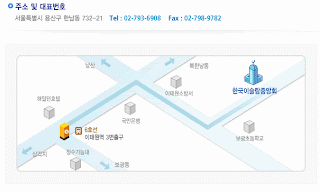 'Click on the map for an enlarged image'
'Click on the map for an enlarged image'More information on Islam, the Mosque and its activities can be found at 'Korea Muslim Federation's' website.
Address:732-21 Hannam 2 Dong, Yongsan-gu, Seoul, South Korea
Telephone:82+ 2+ 793-6908
Website: http://www.koreaislam.org
Note
A very comprehensive post by the blogger "Old Knicks man" on: how many mosques do we have in Korea (한국에는 이슬람교 성원이몆개나 있을까요)? Read Here.
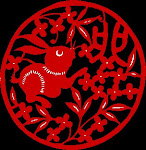





































 sarahinsouthkorea
sarahinsouthkorea
